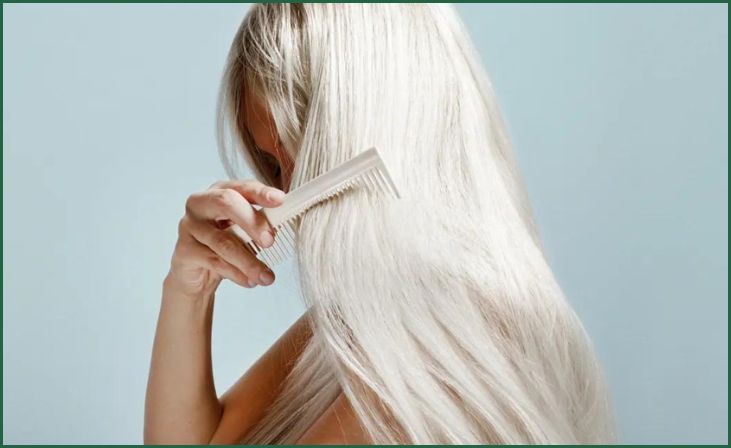Keratin treatments have emerged as a popular solution for those seeking smooth, frizz-free hair. Comprising a specialized formula that infuses the hair with keratin, a structural protein, these treatments promise to transform unruly locks into sleek, manageable strands.
As the demand for smoother, more manageable hair continues to rise, understanding the intricacies of keratin treatments becomes essential. From the chemical processes involved to the variety of formulations available, this guide aims to provide a comprehensive overview.
We’ll explore the benefits, potential risks, and aftercare considerations associated with these treatments, equipping you with the knowledge needed to make informed decisions about achieving the desired look for your hair.
Whether you’re a first-time candidate or a seasoned enthusiast, delving into the world of hair-smoothing keratin treatments unveils a realm of possibilities for achieving salon-quality results at home or in a professional setting.
Table of Contents
ToggleHow Keratin Treatments Work
Keratin treatments work by harnessing the power of a key structural protein—keratin—naturally found in hair, skin, and nails. The process involves a meticulous application of a specially formulated solution that typically contains keratin, along with other ingredients designed to enhance hair texture. The fundamental steps of how keratin treatments work are as follows:
- Preparation: The hair is washed with a clarifying shampoo to remove any residue and open the cuticles, ensuring better absorption of the treatment.
- Application: The keratin solution is evenly applied to sections of the hair, coating each strand thoroughly. Some formulations may include additional ingredients like formaldehyde or alternative chemicals to facilitate the smoothing process.
- Chemical Reaction: The applied solution is activated, often with the help of heat from a flat iron. This triggers a chemical reaction that binds the keratin to the hair shaft, filling in gaps and irregularities.
- Sealing the Cuticles: The heat and chemical reaction work in tandem to seal the keratin into the hair cuticles, creating a protective layer. This layer helps to smooth the hair, reduce frizz, and enhance overall manageability.
- Rinse and Dry: After the treatment has set, the hair is rinsed, and in some cases, a specific shampoo and conditioner are applied. The hair is then dried and styled according to the desired look.
Also, Read – Benefits of Having Short Hair
Things to Know About Hair-Smoothing Keratin Treatments
Keratin

Keratin is a protein naturally found in hair, skin, and nails. In hair care, keratin treatments involve applying a solution containing this protein to the hair, aiming to strengthen and smooth the hair cuticle.
The process typically includes heat application to bond the keratin, resulting in reduced frizz, enhanced shine, and improved manageability. While suitable for various hair types, formulations may contain formaldehyde, requiring consideration of potential health risks.
Results are temporary and fade gradually with washing, necessitating proper aftercare for longevity. Keratin treatments can be a significant time and cost investment, requiring consultation with a professional stylist.
Treatment Process
During a keratin treatment, a specialized solution, often containing keratin and other ingredients, is applied to the hair. The stylist then uses heat, usually from a flat iron or infrared tool, to seal the solution into the hair cuticle.
This process aims to create a protective layer, smoothing the hair shaft and reducing frizz. The heat helps the keratin bond to the hair, resulting in improved strength and manageability.
The duration of the treatment can vary, but it generally takes several hours. Following the treatment, proper aftercare, such as using sulfate-free shampoos and avoiding excessive heat, is crucial for optimal results.
Results
Keratin treatments deliver smoother, more manageable hair with reduced frizz and enhanced shine. The primary outcome is a temporary transformation that lasts weeks to months, gradually diminishing with each wash.
The treatment’s effectiveness depends on factors like hair type and maintenance. It is particularly beneficial for curly, wavy, or frizzy hair.
While results vary, many individuals experience softer, sleeker hair that is easier to style. It’s important to follow stylist-recommended aftercare practices, such as using sulfate-free shampoos, to maximize and prolong the treatment’s positive effects.
Also, Read – Fluffy Short Haircuts for 2023
Don't just scroll, subscribe!
BuzzTrail's unique web-stories are the cure for boredom you've been waiting for.
Duration of Results

The longevity of keratin treatment results varies, typically lasting from a few weeks to a few months. Factors influencing duration include hair type, the specific product used, and post-treatment care. The treatment gradually fades as hair is washed, with the initial smoothness and manageability diminishing over time.
To extend the results, it’s crucial to adhere to aftercare instructions provided by the stylist, which may involve using sulfate-free shampoos, avoiding excessive heat styling, and minimizing exposure to factors like chlorine and saltwater.
Understanding the temporary nature of the results helps individuals manage expectations and plan for maintenance as needed.
Compatibility with Different Hair Types
Keratin treatments are compatible with various hair types, including curly, wavy, and frizzy textures. The effectiveness, however, can vary. Specific formulations cater to different needs; some are designed for particular hair types, ensuring optimal results.
The treatment works by smoothing the hair cuticle, offering benefits like reduced frizz and enhanced manageability. While generally suitable for diverse hair textures, consultation with a professional stylist is recommended to determine the most appropriate type of keratin treatment for individual hair needs and preferences.
This personalized approach helps address specific concerns and ensures the best possible results for each hair type.
Chemical Composition
Keratin treatments often involve a solution with a primary ingredient—keratin, a protein naturally found in hair. Traditional formulations may contain formaldehyde or formaldehyde-releasing compounds, which aid in the bonding process but raise potential health concerns. Formaldehyde-free options are available, prioritizing safety.
The chemical composition varies among products, and it’s crucial to be aware of ingredients, especially for individuals with sensitivities. Choosing formaldehyde-free formulations or discussing concerns with a stylist ensures a safer application.
Understanding the chemical composition helps users make informed decisions based on their preferences, health considerations, and desired results.
Aftercare and Maintenance
Proper aftercare is crucial for maintaining keratin treatment results. This typically involves using sulfate-free shampoos to preserve the smoothing effects and extending the longevity of the treatment.
Additionally, it’s advisable to avoid excessive heat styling, as high temperatures can impact the treatment’s effectiveness. Protecting hair from chlorine and saltwater helps prevent premature fading.
Following the stylist’s instructions on aftercare ensures optimal results, as does scheduling regular touch-ups to address any gradual reduction in smoothness. With mindful maintenance, individuals can enjoy prolonged benefits from the keratin treatment while keeping their hair healthy and vibrant.
Cost and Time Commitment

Keratin treatments require a significant investment of both time and money. The cost varies based on factors such as the salon’s location, the length of the hair, and the specific product used. Treatment sessions typically take several hours, with the process involving the application of the keratin solution and heat sealing.
It’s essential to consider the time commitment, especially for those with busy schedules. While the results are transformative, individuals should weigh the cost and time against the desired benefits to determine if a keratin treatment aligns with their lifestyle and preferences. Consulting with a professional stylist provides insights into specific costs and duration.
Conclusion
In conclusion, keratin treatments offer a transformative solution for individuals seeking sleek, frizz-free hair. Understanding the chemistry behind these treatments, their benefits, and potential drawbacks is vital for informed decisions. While they provide immediate results, ongoing care and consideration of individual factors are crucial.
Whether opting for professional salon treatments or at-home applications, balancing the desire for smooth locks with long-term hair health remains key. As trends evolve, so does the landscape of hair-smoothing options, prompting a thoughtful approach to achieving and maintaining the desired look.
FAQs
Are keratin treatments safe for all hair types?
Are keratin treatments safe for all hair types?
While generally safe, the suitability of a keratin treatment depends on your hair type and condition. Consultation with a professional stylist is crucial to determine compatibility and avoid potential issues.
How long do the results of a keratin treatment last?
How long do the results of a keratin treatment last?
Results can last anywhere from a few weeks to a few months, depending on factors like hair type, maintenance, and the specific treatment used. Regular touch-ups are often needed to maintain the desired effect.
Can you color your hair after getting a keratin treatment?
Can you color your hair after getting a keratin treatment?
In most cases, it’s recommended to color your hair before the treatment. However, some treatments allow for coloring post-treatment, but it’s essential to wait a specified period to ensure optimal results.

